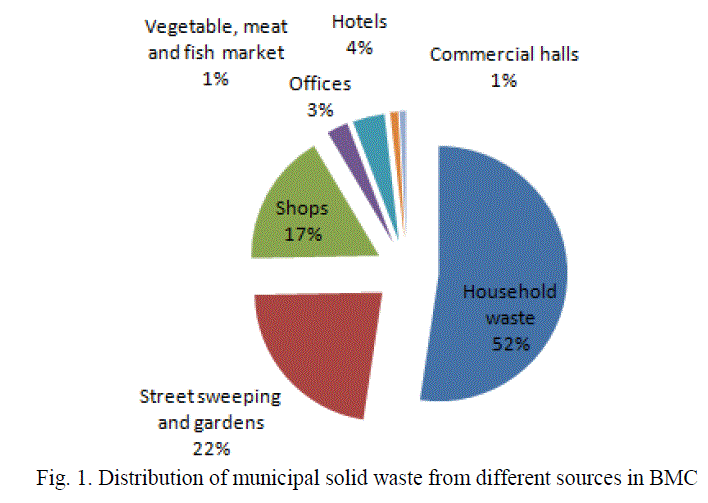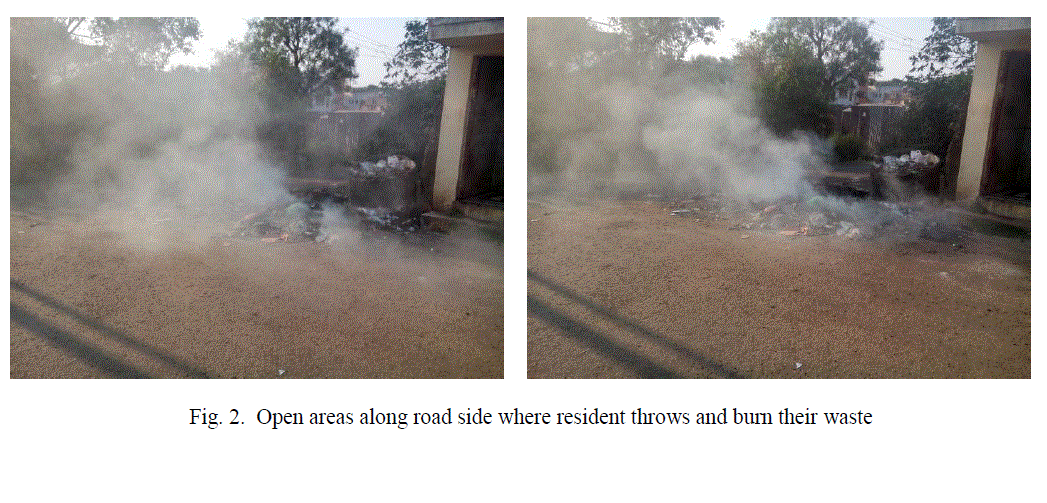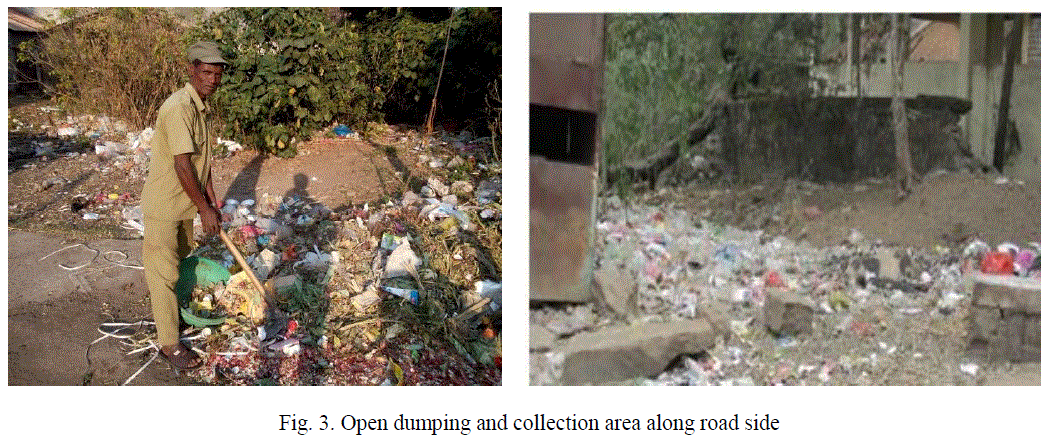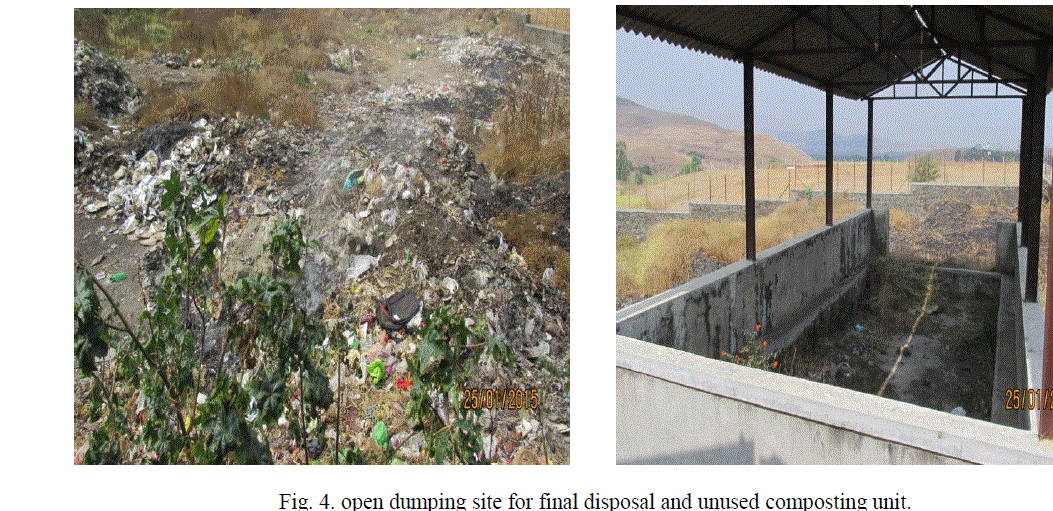ISSN ONLINE(2319-8753)PRINT(2347-6710)
ISSN ONLINE(2319-8753)PRINT(2347-6710)
G. S. Jadhav1, K.R. Takale2, N. R. Kokane2, P. D. Bhilare2, A. B. Sondkar2, S. V. Kank2
|
| Related article at Pubmed, Scholar Google |
Visit for more related articles at International Journal of Innovative Research in Science, Engineering and Technology
To prepare efficient, economical and effective solid waste management plan requires present status and its future perspectives. This paper presents an overview of current solid waste management (SWM) practices in Bhor town, sub urban area of Maharashtra, India and suggests solutions to some of the major problems. Approximately 5.96 ton/d of solid waste are generated in the Bhor Municipal Council area. Deficiencies were found in all elements of SWM. The budget allocation for 2014–2015 was Rs. 20 lakhs, which amounts to Rs. 105/cap-y on SWM. This expenditure is insufficient to provide adequate SWM services. Major deficiencies were found in all elements of SWM. The collection process is deficient in terms of manpower and vehicle availability. No collection bin are provided, people throws their waste in open spaces, thus contributing to the inefficiency of the collection system. Presently no treatment is provided to the waste and waste is dumped on open land after collection. Lack of suitable facilities (equipment and infrastructure) and underestimates of waste generation rates, inadequate management and technical skills, improper collection, and route planning are responsible for poor collection and transportation of municipal solid wastes. Waste generation rate in municipal council area is approximately 0.314 kg/capita/day. Approximately 70% of the MSW generated is compostable wastes and mean moisture content and organic matter content is large in amount. The recommended system deals with maximizing recycling and minimizing land filling of the MSW. Thus, vermincomposting or energy recovery becomes as a suitable alternative as final treatment process to the organic fraction.
Keywords |
| Municipal solid waste, waste analysis, physical characteristics. |
INTRODUCTION |
| Domestic and commercial wastes are commonly termed as MSW and both these account for bulk of the waste in developing countries [1]. More than 90% of the MSW generated in India is directly disposed on land in an unsatisfactory manner [2]. Open dumping as mode of disposal leds to unhygienic condition to surrounding areas, ground water pollution, soil pollution and ambient air pollution. Environmentally acceptable management of municipal solid waste (MSW) has become a global challenge due to limited resources, an exponentially increasing population, increasing waste generation growth rate, rapid urbanization and worldwide industrialization [3]. To design an efficient management system, that consider the appropriate final treatment of MSW based on their physical characteristics, is important to consider the following basic parameters: Density, per capita generation, Moisture content and volatile solids. Solid wastes are disposed of either in open dumps or sanitary landfills, or by incineration. As incineration and sanitary land filling are expensive, both in initial investment and throughout their operation, their use is mostly confined to developed countries, while open dumping is the method used in economically developing countries, mainly due to its simplicity and low cost [4]. The objective of this paper is to analyze some of the strengths and deficiencies in the current MSW management system in bhor and propose feasible solutions. |
II MATERIALS AND METHODS |
| The study was conducted in close accordance with the objectives. The data was collected from the Bhor municipal council. Additional investigation tools for data collection included observations, especially of different components of municipal waste management system such as generation collection and disposal. During the field observations, the study team adopted physical observation rather than a âÃâ¬Ãâquestion and answer session‘ with the residents and municipal council employees to enhance the quality of data and information collected. In addition Physical analyses of household waste; market waste; commercial, hotel and restaurant waste was done by study team. Samples for physical analysis were collected from disposal site by using integrated sampling method. |
III RESULT AND DISCUSSION |
Municipal solid waste (MSW) management |
| Bhor is a small city situated in Pune district of Maharashtra. It is located in western ghat of India on the south bank of River Nira. Bhor is located at 18°10′0″N 73°51′0″E. It has an average elevation of 588 metres (1929 feet).The Bhor Municipal Council (BMC) area has a population of almost 18391 as per census of India 2011 and an area of 8.36 km2. Solid waste management is a statutory function and Bhor Municipal Council (BMC) is responsible for the management of MSW generated in the city. The city is divided into 17 electoral wards and all operations of solid waste management (SWM) in this area are performed under four heads – sweeping, collection, transportation and disposal. |
Sources and quantities of MSW |
| Major sources of MSW in the Bhor municipal council area are residential areas, commercial/market areas, offices and institutions. Field surveys were carried out by study team to assess the status of MSW generation in the BMC area. Bhor city generates approximately 6 ton/d i.e., 0.33 kg/cap-d of MSW daily. BMC has estimated the amount of MSW generated from various sources in the city, shown in Table 1. |
 |
Collection and disposal of municipal solid waste |
| Due to climatic factors like high temperature and humidity along with high organic matter content, MSW decomposes rapidly resulting in unhygienic conditions. Hence in most areas, collection has to be done on a daily basis [3]. Currently, different collection methods are being used in BMC and include: house-to-house collection (primary collection), and collection from roadside open storage areas. In the BMC area, street cleaning and collection involves collection of MSW from the streets (road sweeping) and collection from roadside open storage areas. House-to-house collection of waste is carried out using Ghantagadi. In BMC area 18 open places were observed, where peoples disposes their waste. This waste is collected once a day and disposed at disposal site. The density of wastes in Indian cities varies from 280 to 660 kg/ m3 [3]; while density of MSW in BMC is 236 kg/m3. BMC aims to provide daily collection, but littering of waste are common features throughout the city. A major factor responsible for this problem is the absence of collection bins. BMC has a total of 5 vehicles for transporting and collecting MSW. These vehicles include Tata- 407, two Ape rickshaws and two Tata Ace. Ape rickshaws and Tata Ace are used for House-to-house collection of waste. It is observed that waste is not collected daily from all places. This might be due to inadequacy of both manpower and financial resources. |
 |
Composition of municipal solid waste |
| Physical analyses of household waste; market waste; commercial, hotel and restaurant waste was done by study team. The average density of solid waste was around 236 kg/ m3. Domestic municipal solid waste samples contain 45 % fruit and vegetable waste and 21 % paper. Waste from the markets contains 28 % leaves, hay and straw; and 35 % fruit and vegetable waste. The average moisture content in city waste is around 60%. |
Gaps in the present SWM scenario and possible solutions |
| Study and analysis of present solid waste management practices by BMC shows that there are many gaps that need to be addressed to make it effective, efficient and economical. Major problems are discussed here and possible solutions proposed. |
 |
Littering along roadside open areas |
| Sweeping in the main and commercial area is done regularly and fairly well whereas in the adjacent slum areas, it is neither daily nor regular. Waste collection from main area is done regularly, but residents, particularly from low income groups and shopkeepers frequently throw their waste onto streets and roads and into open spaces and open drains after collection time. In BMC 18 places were observed, where a resident, shopkeepers throws their waste, which causes littering along the road causes clogging of drainage system (fig. 2). To avoid this problem, BMC should provide collection bins at all 18 places which will avoid littering of waste. In addition BMC should plan for waste collection considering working hours of people and notify residents of the time of waste collection to avoid littering and introduce fines for throwing waste on roads or streets, or in open drains. |
 |
Lack of labor and resources and poor working conditions |
| Almost 25 % waste is collected by Ghantagadi; where as 75 % of waste is thrown by residents in 18 open areas. Almost 70-75 % of waste generated is collected daily; remaining waste is burnt in open areas, this result in unhygienic conditions, foul smell and odor. Total of 20 sanitation workers are distributed among all activities of SWM. There is 1.1 staff allocated per 1000 people. The current norm in the country is 2.8–3.5 workers/ 1000 population, which is likely to be a gross underestimate of requirements [3]. Collection of waste is done manually. Manual collection and transfer is unhygienic to the sweepers and staff. Most of the waste collectors suffer from parasitic diseases like jaundice, diarrhea, and trachoma [5]. There is much higher requirements for solid waste collection staff. Another option effective and hygienic solid waste management is to provide collection bins at required location and use automatic mechanical system for loading. This will reduce possibilities of handling, as well as poor collection efficiency. Awareness among people should be generated so that they do segregate their wastes in different containers and collectors do not have to segregate the wastes. In spite of huge effort by BMC, due to lack resources poor collection and inadequate transportation of wastes continue and result in the accumulation of waste throughout the city. A lack of suitable facilities, shortage of labors, management deficiency and improper route planning are responsible for poor collection. |
Separation at source, collection and transportation |
| Another option for effective and efficient solid waste management is to segregates their waste at source into different categories such as recyclable, biodegradable etc. Therefore rag pickers can collect and sell recyclable waste at source and generate some income for themselves, which will reduce load of waste collection ant transportation system. This will improve the efficiency of municipal solid waste collection and recovery, as well as it will provide job opportunities for the informal waste collectors. The average density (236 kg/m3) of waste in the BMC area is quite high. Almost 60% portion of household waste is biodegradable. Also, the moisture content is too high for the waste, such a waste need additional fuel for incineration. If such waste is segregated as source, then composting under natural conditions or in engineered reactors can be carried out efficiently and economically. This will make overall system effective using biodegradable portion for composting and non-biodegradable portion at landfill. |
Treatment strategies and unscientific disposal method |
 |
| At present, no treatment is provided for collected municipal solid waste. Almost 100 % of the waste collected directly disposed in landfill in an unsatisfactory manner and burnt after drying. This method of dumping has led to leachate problem. Further open burning of waste led to ambient air pollution. Two composting plants having volume of 60.92 m3 are available but not utilized for treatment (fig. 4). This might be due to non availability of technical manpower. Further, unscientific disposal methods not only cause adverse effects on the environment and on human health, but also decrease land availability for disposal and other uses. Almost 60 % portion of MSW is biodegradable. Material and energy recovery is best option for efficient, effective and economical solid waste management system [6]. |
IV CONCLUSION |
| Around 6 ton/d of solid waste are generated in the BMC area and around Rs. 105/ cap-y have been allocated for SWM in 2014– 2015. This expenditure remains insufficient for providing adequate SWM services. Deficiencies in each of the elements of an integrated SWM system are summarized here |
| Collection of waste |
| Collection bins are not provided to collect the waste; resident and shopkeepers throws their waste in open areas. Collection efficiency is around 70%. Vehicles owned by BMC are inadequate in number. Another major issue is shortage of manpower for collection. These gaps in the system point to the need for upgrading current equipment and using more rational management methods for routing vehicles. |
Treatment and disposal of Waste |
| At present, no treatment is provided for collected solid waste. Open dumping practice is used for disposal which causes adverse impacts on environment of surrounding areas. Almost 100% of the total collected waste is directly disposed in landfill in an unsatisfactory manner without providing earth cover. This method of dumping is led to ambient air pollution and ground water pollution. BMC has two composting units but not in use. This might be due to lack of technical manpower |
References |
|